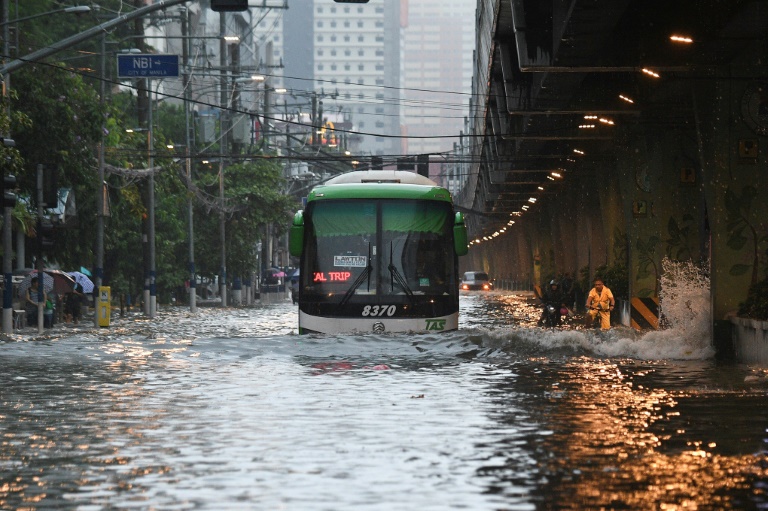Incessant rains battered the northern Philippines on Wednesday, causing flooding in Manila and landslides in mountainous areas as Typhoon Gaemi worsened the seasonal monsoon.
In the densely populated capital, rescue workers were deployed across the city to evacuate people from low-lying homes after downpours turned streets into rivers and left vehicles stranded.
People held on to flimsy umbrellas as they waded through the thigh-high, murky water, or used small boats and shopping carts to get around.
“The disruption it caused was enormous. The water reached the second floor of our house,” Nora Clet, a housewife, told AFP.
Restaurant worker Rex Morano said he was unable to work due to the “very high” flood waters.
A state of emergency was declared in Manila, freeing up funds for emergency relief, with the state weatherman warning of “severe flooding” in some areas.
Government offices were closed and classes suspended. At least 80 domestic and international flights were canceled and tens of thousands of customers were left without power due to the weather.
Some shopping centers provided temporary shelter to those affected.
“Many areas are flooded, so we have deployed rescue workers across the city. There is an overwhelming number of people asking for help,” Peachy de Leon, a disaster official in the outskirts of Manila, told AFP.
“We were told last night that it wouldn't rain, but then it suddenly started raining and we were quite shocked. A search and rescue operation is now underway.”
Typhoon Gaemi, which was barreling through the Philippines on its way to Taiwan, has intensified the southwest monsoon rains typical of this time of year, the state weatherman said.
“Normally the rainy season is at its peak in July and August and now there is a typhoon in the eastern waters of the Philippines that is strengthening the southwest monsoon,” senior weather specialist Glaiza Escullar told AFP.
According to Escullar, more than 200 millimeters (almost eight inches) of rain has fallen in the capital in the past 24 hours, which is “not unusual.”
Heavy rainfall was expected again on Thursday.
Landslides killed a pregnant woman and three children in Batangas province, south of Manila, and blocked three major roads in the mountainous province of Benguet, police and disaster officials said Wednesday.
This brings the death toll from heavy rainfall in large parts of the country in the past two weeks to at least 12, as tens of thousands of people sought refuge in evacuation centres.
President Ferdinand Marcos on Wednesday ordered disaster management officials to ensure adequate food supplies for the hardest-hit areas, saying “their situation is critical.”
The poor neighborhoods near Manila Bay were hit hard, with most streets flooded and more than 2,000 people forced to flee their homes.
About 20 major storms and typhoons strike the Philippines and surrounding waters each year, damaging homes and infrastructure and killing hundreds of people.
pam/amj/fox

